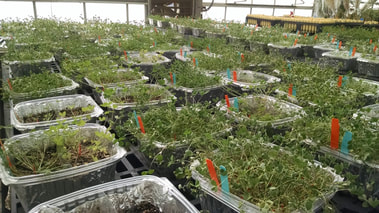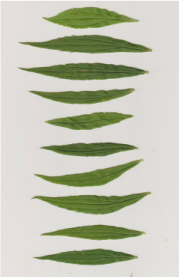Research
|
Establishing links between functional traits, fitness, and community dynamics
The expectation that functional traits influence fitness is foundational to trait-based ecology, but empirical estimates of the relationship between traits and fitness across species and environments are lacking. To fill this gap, we've developed an approach that uses population models to integrate the effects of traits on demographic rates across species and over the life cycle to estimate the net effect of traits on population fitness, revealing the contours of fitness landscapes and how they vary across environmental gradients. We've used this approach to estimate fitness landscapes of trees in the eastern US across a temperature gradient and simulate forest dynamics in response to changes in climate and disturbance regimes. Testing the role of soil mutualists in plant species coexistence At Bodega Marine Reserve in northern California, eight species of native, annual clovers (Trifolium) have co-occurred at extremely fine scales for decades. This raises the question: what allows these closely related and ecologically similar species to coexist? Using field and greenhouse experiments, we are examining the roles of N-fixing rhizobial mutualists and other aspects of the plant niche in stabilizing coexistence of Trifolium species and asking whether these experimentally-measured mechanisms can explain coexistence dynamics in the field. Patterns and consequences of intraspecific trait variation Plant species are known to display large variation in functional traits, but the extent and consequences of this variation at the community level are poorly understood. My dissertation research at Syracuse University focused on the role of intraspecific trait variation in the assembly of old-field plant communities in central New York and across the eastern United States. I used observational field studies at local to regional scales and field experiments to assess the role of intraspecific trait variation in community assembly and functional trait responses to the environment. I found that intraspecific trait variation plays a key role in community assembly and functional responses to edaphic variation and experimental environmental manipulation at local scales, whereas interspecific trait variation was most important in structuring communities across broad-scale climatic gradients. Macroecology and biogeography I am interested in using existing datasets to examine broad-scale ecological patterns and processes and to find general answers to basic ecological questions. Here are some examples: What is the relative extent of intraspecific vs. interspecific trait variation in plant communities worldwide, and how does this vary among traits and communities? Working with Cyrille Violle at CEFE and over 40 other collaborators, we conducted a global meta-analysis encompassing 629 communities and 36 functional traits to provide the most comprehensive view to date of the importance of intraspecific trait variation at the community level. Do upper elevational limits of tree species match their poleward latitudinal limits? Can species' dispersal traits explain climatic mismatches between these limits? In collaboration with Mark Lesser and Jason Fridley, we tested the correspondence between upper range limits of tree species along an elevational gradient in the Great Smoky Mountains and a latitudinal gradient in eastern North America. We found close correspondence in summer temperature and growing season length, but large mismatches in winter temperature, between species' upper and northern limits. These results suggest that summer heat and growing season length requirements, and not cold tolerance, determine species' range limits. We also found that climatic mismatches could be explained by species' dispersal traits, suggesting that species with poor dispersal ability fail to reach their potential poleward climatic range limits. What are the spatial patterns of functional beta diversity in tree communities, and are these patterns driven by stochastic or deterministic assembly mechanisms? I collaborated with Catherine Ravenscroft, Nate Swenson, and Michael Weiser to describe patterns of functional turnover along geographic and environmental gradients in eastern North American trees and test whether these patterns differed from expectations based on stochastic dispersal. We found that functional beta diversity was lower than expected on fine scales, indicating functional convergence in similar environments, and higher than expected on broad scales, indicating functional divergence across strong environmental gradients. These results demonstrate the role of deterministic environmental filtering of tree species based on their functional traits in the assembly of eastern North American forests. Does the relative importance of edaphic vs. climatic factors as drivers of plant community composition change with spatial scale? In a project of the Plant Ecology and Evolution Seminar (PEES) group at Syracuse University, we conducted a meta-analysis of studies of vegetation-environment relationships worldwide. We found empirical support for a transition from primarily edaphic to primarily climatic control of plant community composition with increasing spatial scale (grain and extent) and identified scale thresholds that mark this transition. |
|



